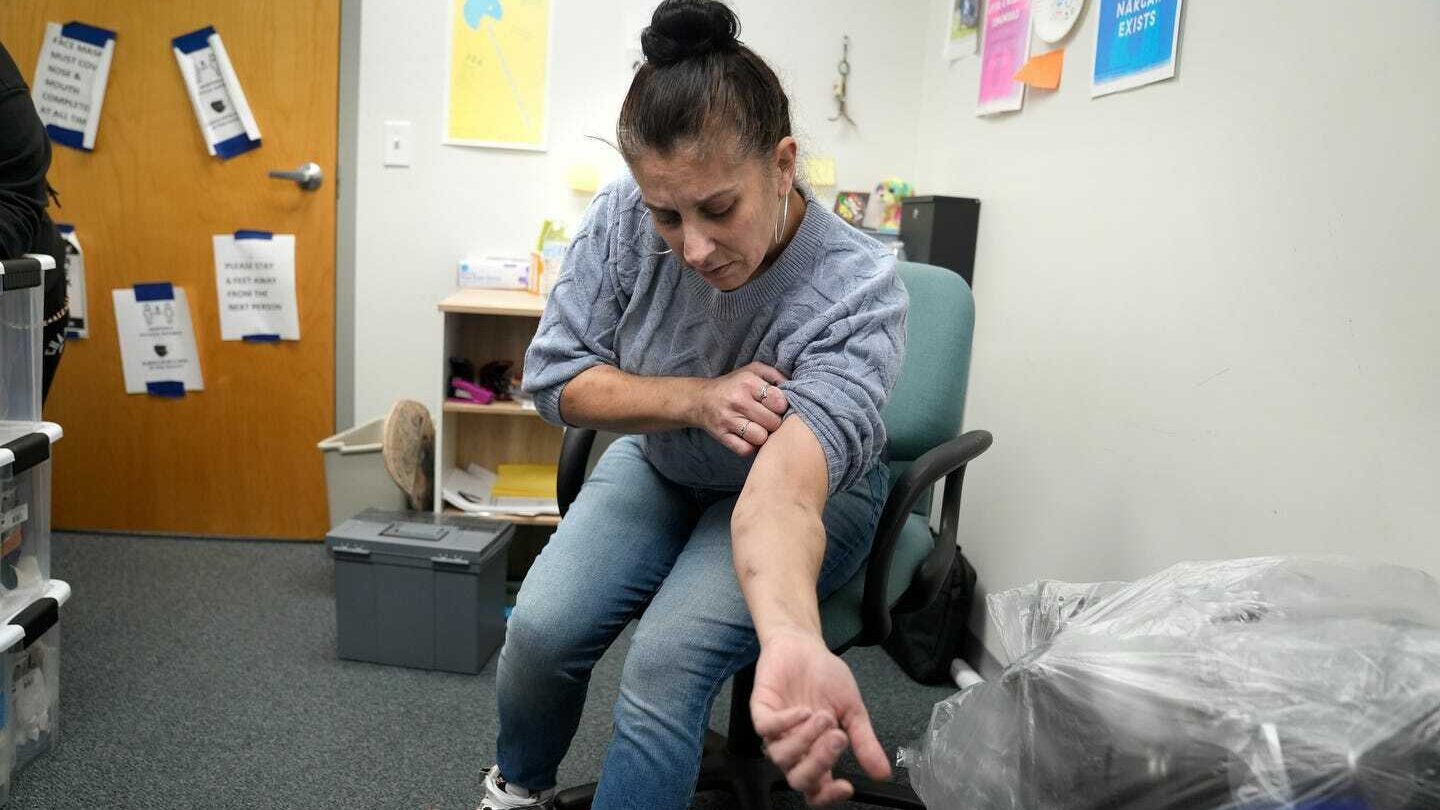Public health and law enforcement agencies around the U.S. are scrambling to blunt the impact of xylazine, a deadly new threat to Americans who use street drugs.
That effort is complicated — some critics say crippled — by the fact that no one’s sure who’s mixing the dangerous chemical into fentanyl, methamphetamines and other street drugs. It’s also unclear why they’re doing it.
“Why has it gone national? I don’t know why. Tough question out of the gate,” said Dr. Nabarun Dasgupta, a researcher at the University of North Carolina who tests street drugs collected around the country.
Xylazine, or “tranq,” is a horse tranquilizer used by the veterinary industry. Dasgupta says the mystery around it points to a wider public health problem: State and federal agencies lack the capacity to identify and track new drug threats in real time.
“We only find out what’s in the street drug supply when it’s too late, when people are either dead or arrested,” Dasgupta said.
NPR contacted many of the top street drug experts in country. All agreed the government was woefully late grappling with the spread of fentanyl and is now playing catch-up on xylazine.
Because there’s no national system for identifying drug threats quickly, most of them said the U.S. will likely be caught off guard by other emerging street drugs.
“What is happening right now? I don’t know,” said Dr. Nora Volkow, head of the National Institute on Drug Abuse.
“If you want to actually be nimble and flexible and do the interventions on the basis of what you are observing, you need timely data,” she said. “Otherwise, you’re doing it with your eyes closed.”
The Biden administration has moved to improve collection of real-time data on street drugs and nonfatal overdoses, but officials acknowledge that national data collection and sharing remains primitive.
“It just eats your skin away”
“I’m deeply concerned about what this threat means for the nation,” Dr. Rahul Gupta, the White House director of the Office of National Drug Control Policy, said in May when he warned that xylazine is a major emerging health threat.
According to Gupta’s office, xylazine-positive overdose deaths increased tenfold in the southern U.S. from 2020-2021, sevenfold in the western U.S. and fivefold in the Midwest. Most of those drug deaths also involved fentanyl.
Gupta acknowledged many cities and towns are flying blind.
“Testing for xylazine is uneven across the United States, which makes it hard to get the national picture,” he said. “Many communities are not even aware of this threat in their backyards.”
Over the years, xylazine has occasionally turned up in street drugs, but over the past 12 months, it suddenly went viral.
Overdose deaths and severe medical complications — including terrible flesh wounds caused by the chemical — have soared in the South and West, where xylazine had been almost unknown.
“It just eats your skin away and it leaves a hole and then it leaves a scar,” said Jessica, who lives in New Castle, Del. NPR agreed not to use her last name for privacy reasons and because illicit drug use is illegal.
She spoke while at a harm reduction van, where she turned up with bandages on her legs from xylazine-related wounds. “It goes fast, it just literally eats your skin away,” Jessica said.
Xylazine also makes it much harder to revive people after fentanyl overdoses, and the chemical adds another layer of intense addiction and cravings.
“People who are in this are getting sucked further and further and further in,” said KC, who uses street fentanyl in Dover, Del. She said xylazine is making addiction deadlier and harder to escape. “It just feels kind of hopeless right now.”
Drug experts say they only have theories about who’s adding xylazine into street drug cocktails — and why.
“We are unable to provide more detail at this time”
One possibility is that it’s happening locally, with drug gangs in places across the U.S. suddenly adopting this deadly new ingredient as a way to cut or dilute fentanyl powder.
“You could think of a kitchen table,” said Dasgupta. “You’re sourcing powder and you’re mixing it together the same way you would mix up the baking soda, salt and sugar for pancakes with the flour.”
But some experts think xylazine might be entering the supply chain earlier, before Mexican cartels ship fentanyl and methamphetamines across the border.
Volkow says new drug-sample data collected inside Mexico lends support to that theory. “Maybe the products are coming already mixed into the United States,” she said.
Why would cartels and dealers suddenly decide to make fentanyl — an already deadly street drug — even riskier? Again, policy experts only have theories.
One possibility, Volkow said, is simple convenience. Until recently, xylazine wasn’t regulated or controlled, so it was relatively easy to source.
“Xylazine is a perfect filler. It’s basically very, very cheap. On top of that, it may be enhancing the duration of these drugs,” she said.
This points to another theory about the surge in xylazine use.
Some people experiencing fentanyl addiction believe Tranq extends their high or delays onset of withdrawal symptoms.
That could be appealing in part because law enforcement has been squeezing the supply of street fentanyl, trying to make it harder to get and more expensive.
“That’s really driven drug manufacturers to start to integrate xylazine into the supply. It’s cheaper and it also makes the high last longer,” said Maritza Perez Medina a researcher at the Drug Policy Alliance.
NPR reached out to the Drug Enforcement Administration — the top law enforcement agency in the U.S. fighting street drugs — but DEA officials declined to be interviewed and sent a brief statement.
“DEA continues tracking and monitoring this emerging drug threat, including all possible sources and levels at which it is entering the illicit drug supply,” the statement said. “We are unable to provide more detail at this time.”
Why don’t we track drug threats the way we tracked COVID?
The lack of accurate, real-time data about emerging drug threats angers people on the front lines of the overdose crisis, which killed 110,134 people in the U.S. last year alone.
“Do you remember when COVID started happening? You saw the map, you saw where places where … hotspots were?” said Levi Wardell, a funeral home director in Cheyenne, Wyo., who works with families who have lost loved ones to fatal overdoses.
“Why in the hell would that not be available for this [public health crisis]?” he asked.
Technology exists to track emergent drug threats by testing wastewater. Experts say it also would help if law enforcement agencies were required to swiftly share data they collect about street drugs into a national system accessible to public health agencies.
So far those ideas haven’t gained traction. That leaves harm reduction groups like OnPoint in New York City struggling to sample drugs locally and gather whatever information they can about new substances that might be spreading.
“We have national harm reduction calls once a month or so, and we’re always checking in with each other. What’s there? What are you finding here, what are you finding there?” said Sam Rivera, OnPoint NYC’s executive director.
Experts say this kind of grassroots networking can help, but it’s not enough in an era when more synthetic street drugs — perhaps more deadly than xylazine — are expected to emerge quickly.
Government officials acknowledge that by the time the xylazine mystery is solved and public health measures are in place to make it less harmful, the next toxic street drug could already be taking hold.
“We are also looking ahead to what potentially comes after xylazine as an additive to fentanyl, in order to get ahead of the next additive to the drug supply,” said the White House’s Gupta.
Madelyn Beck with the nonprofit news organization WyoFile and Paul Kiefer with Delaware Public Media contributed reporting for this story.
Copyright 2023 NPR. To see more, visit https://www.npr.org.
9(MDAxODM0MDY4MDEyMTY4NDA3MzI3YjkzMw004))

9(MDAxODM0MDY4MDEyMTY4NDA3MzI3YjkzMw004))








